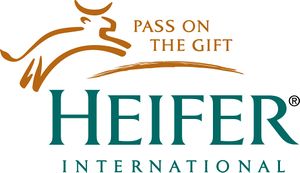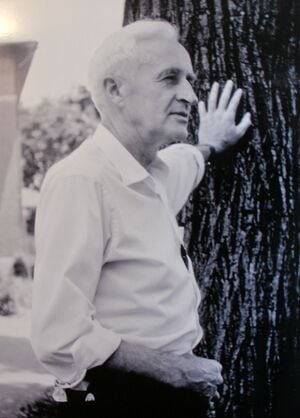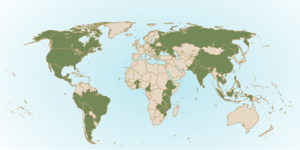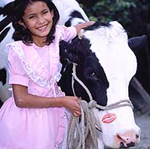'
Heifer International is a charity organization that collects donations and sends them to families in countries abroad in order to help them reach self-sustainability. Donors make gifts of money which are put towards purchasing animals, natural resources and other farming resources. Heifer’s mission, as stated on its website, is “to work with communities to end hunger and poverty and care for the Earth.” It intends to achieve this goal through teaching impoverished families how to utilized the resources they are gifted, rather than just having those gifts be for one-time use, or, as Heifer puts it, to work under the “teach a man to fish” philosophy.

History[edit | edit source]

Heifer International Founder, Dan West, was born in Ohio in 1893. As a member of the Church of Brethren and a graduate of Manchester College, West was opposed to settling differences with violence. He did not support the fighting in World War I, instead, West worked for the Emergency Peace Campaign. In 1936, West traveled to Spain to help rebuild after the Spanish Civil War. While there, he thought about he could benefit the children in Spain. He noticed that the children enjoyed drinking milk, and he wanted to find a way to bring them more. He realized that it was difficult for recovering country to have imported milk. It was then that he hatched the idea of bringing the whole cow to the rebuilding country, so that the milk could be produced right there. This is how West created his concept, “not a cup but a cow.” The idea here was to import livestock, so that it would help provide nourishment for the developing area, instead of having them be dependent on imported products. When West returned to the United States, he began spreading word of his idea. In 1942, West and the Church of the Brethren established “Heifers for Relief.” The project’s first shipment imported 17 heifers to Puerto Rico in 1944. The following year, the project started to send “seagoing cowboys.” These cowboys were sent to escort the livestock and make sure that they got their safe. “Heifer for Relief” was later renamed “The Heifer Project,” and imported cattle that would give birth to multiple generations of calves for developing or rebuilding countries. Dan West died in 1971, and his project was then turned into “Heifer Project International.”
Heifer’s Mission[edit | edit source]
Heifer International aims to prevent hunger and poverty in the long-run by creating sustainable economic situations for families in countries around the world. The organization works with families to build up sustainable communities of commerce and agricultural production. Animals that families receive through Heifer are used for their products, such as milk and eggs, rather than eaten. Families are taught how to manage farms and allocate their resources effectively, so that in the long term they will eliminate dependence on charity. In this way, Heifer lives up to its mission of “Passing on the Gift.” Because families are taught to be self-supporting and not to rely on charity, Heifer believes that they will have greater opportunities to increase their income and occupational situation, and therefore to give their children education, and generally stimulate the economy. In the big picture, Heifer hopes that teaching families to work together and to manage farms and cooperatives will ultimately benefit the greater area, if the families learn to cooperate and manage production efficiently and responsibly.
Donating to Heifer[edit | edit source]
Heifer International sends out seasonal gift catalogs to residential areas, listing all the causes donations may be put towards. While the catalog specifies what portions of resources each amount of money may afford, the money may not be put towards the purpose the person specifies. For instance, if a person donates $10 towards helping a family afford a “share of a sheep,” the money may not be used on sheep exclusively. The money donated to Heifer International is used where Heifer deems to be the area with the greatest need. Among the things the money may be used for, donations fall under certain categories: animals, promote women’s empowerment, support sustainable farming, provide basic needs, and fund a project. Animals include goats, heifers, camels, water buffalo, llamas, sheep, pigs, fish, rabbits, honeybees, ducks, chickens, and geese. Donating to “women’s empowerment” means helping launch a small independent business, giving a gift basket, funding a women’s self-help or support group, sending girls to school, or aiding in livestock development. Supporting sustainable farming entails providing the means for trees or gardens to be planted and developed. Providing basic needs goes towards clean water and irrigation pumps, stoves, and promoting medical and nutritional health. Money may be donated in the form of “shares,” which means part of the cost of providing one item, such as an animal, or as the “full” value, though any amount is accepted whether or not the money is symbolic of a certain donation.
Heifer’s work[edit | edit source]

Heifer International operates in the following countries: (North America) Guatemala, Haiti, Honduras, Mexico, Nicaragua, USA; (Central/Eastern Europe) Armenia, Romania, Georgia, Ukraine; (Asia/South Pacific) Bangladesh, Cambodia, China, Vietnam, India, Nepal , Philippines; (South America) Argentina, Bolivia, Brazil, Ecuador, Peru; and (Africa) Cameroon, Ghana, Kenya, Sierra Leone, South Africa, Tanzania, Malawi, Rwanda, Senegal, Uganda, Zambia, Zimbabwe. The work Heifer does abroad involves materially providing people with the resources they need to become self-sufficient; doing social work to empower groups; working with families to address the issues present within their families and in the greater community; and founding and funding training programs so that future generations may continue to learn without Heifer’s presence. Heifer also partners with governmental institutions, nonprofit organizations and charity and social networks to promote and develop programs and services. Heifer works with both private and public institutions. Its sponsors, supporters and partners include organic food companies, such as Organic Valley, health and farming organizations, including Farm Journal Agricultural Foundation, eco-friendly programs, and women’s groups.
The Better Business Bureau's Wise Giving Alliance (WGA) reports that Heifer International meets all of its standards for charity accountability. The WGA found that Heifer International is truthful in its representations of how money is spent, does not allocate an excessive part of its budget for fundraising or administrative expenses and makes its financial statements readily available to the public. Charity Navigator gives Heifer International an overall rating of 2 out of 4 stars. 69.8% of expenses go to programs; fundraising and administrative expenses are 30.1%. The American Institute of Philanthropy gave Heifer International an "Open Book Credit" for making complete financial documentation available on request
Heifer International has set 20.7 million families and 94.5 million men, women and children on a path toward prosperity by giving them the tools and training they need to sustain their lives. Thanks to Heifer the families involved see higher incomes, healthier livestock and better access to education. Heifer International consists of 964 Employees and 1,520 volunteers. The Annual Budget for Heifer International in 2011 was $116,643,500. The Maximum Annual Budget is $132,684,192.
Sustainable Farming all around the world to end World Hunger[edit | edit source]
They also aim for Women’s Empowerment. According to Heifer women produce 80 percent of the developing worlds food while owning only two percent of the land. Heifer wants that to change as well as to provide support for women’s groups, training in gender equality and the means to send girls to school.
What can you do?[edit | edit source]
Sign up for Heifer International through email - Donate to those people who need it most - Give stock or securities - Fund a project - Planned Giving
Awards[edit | edit source]
In 2010, Heifer International President Jo Luck was named a co-laureate of the World Food Prize. Heifer International received the 2006 Social Capitalist award from Fast Company magazine. Heifer International also received the 2004 Conrad N. Hilton Humanitarian Prize for its efforts to eliminate hunger and help communities become self-sustaining. It was the first US-based organization to win the $1 million award since 1997. In 2003, Heifer International was named one of Forbes magazine's top 10 charities. In 2007, the Heifer International Headquarters building was named one of the American Institute of Architects Committee on the Environment Top Ten Green Projects. In 2008, the Heifer International Headquarters building was named a National AIA (American Institute of Architects) Institute Honor Award Winner.
Accountability standards[edit | edit source]
The Better Business Bureau's Wise Giving Alliance (WGA) reports that Heifer International meets all of its standards for charity accountability. The WGA found that Heifer International is truthful in its representations of how money is spent, does not allocate an excessive part of its budget for fundraising or administrative expenses and makes its financial statements readily available to the public. Charity Navigator gives Heifer International an overall rating of 2 out of 4 stars. 69.8% of expenses go to programs; fundraising and administrative expenses are 30.1%. The American Institute of Philanthropy gave Heifer International an "Open Book Credit" for making complete financial documentation available on request.
Criticism[edit | edit source]
Heifer has been criticized for using "misleading" advertisements suggesting what the money donated is used for. A Well Fed World criticizes the use of children in advertisements to generate a favorable image with potential donors.

It also says Heifer creates the impression that all animals are healthy and well-adapted to their new environments, while in reality, they may not be well-suited to adjust; in fact, forging an entirely new economy from scratch in a poor, infertile, or economically stagnant area would prove more of a challenge than Heifer claims. The website also says there is a possibility the animals will be unhealthy and their new owners incapable of caring for them properly.
CounterPunch.org criticizes Heifer similarly, saying the organization is promising economic stimulus it cannot realistically deliver. The website also says Heifer's animals may be vessels for diseases, and may be subjected to inhumane treatment and conditions, both during delivery and within the confines of their new homes.
Accomplishments/Statistics[edit | edit source]
Heifer International has set 20.7 million families and 94.5 million men, women and children on a path toward prosperity by giving them the tools and training they need to sustain their lives. Thanks to Heifer the families involved see higher incomes, healthier livestock and better access to education. Heifer International consists of 964 Employees and 1,520 volunteers. The Annual Budget for Heifer International in 2011 was $116,643,500. The Maximum Annual Budget is $132,684,192.
Projects[edit | edit source]
Heifer participates in Sustainable Farming all around the world to end World Hunger. They also aim for Women’s Empowerment. According to Heifer women produce 80 percent of the developing worlds food while owning only two percent of the land. Heifer wants that to change as well as to provide support for women’s groups, training in gender equality and the means to send girls to school.
References[edit | edit source]
Heifer on Wikipedia [1]
World Food Prize [2]
Fast Company review[3]
Hilton Foundation[4]
Forbes[5]
Aiatopten[6]
Heifer International website: About[7]
Charity Reports[8]
Charity Watch[9]
A Well Fed World [10]
CounterPunch[11]